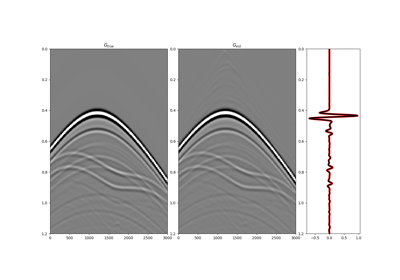pylops.waveeqprocessing.Marchenko¶
-
class
pylops.waveeqprocessing.Marchenko(R, R1=None, dt=0.004, nt=None, dr=1.0, nfmax=None, wav=None, toff=0.0, nsmooth=10, dtype='float64', saveRt=True)[source]¶ Marchenko redatuming
Solve multi-dimensional Marchenko redatuming problem using
scipy.sparse.linalg.lsqriterative solver.Parameters: - R :
numpy.ndarray Multi-dimensional reflection response in time or frequency domain of size \([n_s \times n_r \times n_t/n_{fmax}]\)
- R1 :
bool, optional Deprecated, will be removed in v2.0.0. Simply kept for back-compatibility with previous implementation
- dt :
float, optional Sampling of time integration axis
- nt :
float, optional Number of samples in time (not required if
Ris in time)- dr :
float, optional Sampling of receiver integration axis
- nfmax :
int, optional Index of max frequency to include in deconvolution process
- wav :
numpy.ndarray, optional Wavelet to apply to direct arrival when created using
trav- toff :
float, optional Time-offset to apply to traveltime
- nsmooth :
int, optional Number of samples of smoothing operator to apply to window
- dtype :
bool, optional Type of elements in input array.
- saveRt :
bool, optional Save
RandR^Hto speed up the computation of adjoint ofpylops.signalprocessing.Fredholm1(True) or createR^Hon-the-fly (False) Note thatsaveRt=Truewill be faster but double the amount of required memory
Raises: - TypeError
If
tis notnumpy.ndarray.
Notes
Marchenko redatuming is a method that allows to produce correct subsurface-to-surface responses given the availability of a reflection data and a macro-velocity model [R1c4066d82e61-1].
The Marchenko equations can be written in a compact matrix form [R1c4066d82e61-2] and solved by means of iterative solvers such as LSQR:
\[\begin{split}\begin{bmatrix} \Theta \mathbf{R} \mathbf{f_d^+} \\ \mathbf{0} \end{bmatrix} = \mathbf{I} - \begin{bmatrix} \mathbf{0} & \Theta \mathbf{R} \\ \Theta \mathbf{R^*} & \mathbf{0} \end{bmatrix} \begin{bmatrix} \mathbf{f^-} \\ \mathbf{f_m^+} \end{bmatrix}\end{split}\]Finally the subsurface Green’s functions can be obtained applying the following operator to the retrieved focusing functions
\[\begin{split}\begin{bmatrix} -\mathbf{g^-} \\ \mathbf{g^{+ *}} \end{bmatrix} = \mathbf{I} - \begin{bmatrix} \mathbf{0} & \mathbf{R} \\ \mathbf{R^*} & \mathbf{0} \end{bmatrix} \begin{bmatrix} \mathbf{f^-} \\ \mathbf{f^+} \end{bmatrix}\end{split}\][R1c4066d82e61-1] Wapenaar, K., Thorbecke, J., Van der Neut, J., Broggini, F., Slob, E., and Snieder, R., “Marchenko imaging”, Geophysics, vol. 79, pp. WA39-WA57. 2014. [R1c4066d82e61-2] van der Neut, J., Vasconcelos, I., and Wapenaar, K. “On Green’s function retrieval by iterative substitution of the coupled Marchenko equations”, Geophysical Journal International, vol. 203, pp. 792-813. 2015. Attributes: Methods
__init__(self, R[, R1, dt, nt, dr, nfmax, …])Initialize self. apply_multiplepoints(self, trav[, G0, nfft, …])Marchenko redatuming for multiple points apply_onepoint(self, trav[, G0, nfft, rtm, …])Marchenko redatuming for one point -
apply_onepoint(self, trav, G0=None, nfft=None, rtm=False, greens=False, dottest=False, fast=None, **kwargs_lsqr)[source]¶ Marchenko redatuming for one point
Solve the Marchenko redatuming inverse problem for a single point given its direct arrival traveltime curve (
trav) and waveform (G0).Parameters: - trav :
numpy.ndarray Traveltime of first arrival from subsurface point to surface receivers of size \([n_r \times 1]\)
- G0 :
numpy.ndarray, optional Direct arrival in time domain of size \([n_r \times n_t]\) (if None, create arrival using
trav)- nfft :
int, optional Number of samples in fft when creating the analytical direct wave
- rtm :
bool, optional Compute and return rtm redatuming
- greens :
bool, optional Compute and return Green’s functions
- dottest :
bool, optional Apply dot-test
- fast :
bool Deprecated, will be removed in v2.0.0
- **kwargs_lsqr
Arbitrary keyword arguments for
scipy.sparse.linalg.lsqrsolver
Returns: - f1_inv_minus :
numpy.ndarray Inverted upgoing focusing function of size \([n_r \times n_t]\)
- f1_inv_plus :
numpy.ndarray Inverted downgoing focusing function of size \([n_r \times n_t]\)
- p0_minus :
numpy.ndarray Single-scattering standard redatuming upgoing Green’s function of size \([n_r \times n_t]\)
- g_inv_minus :
numpy.ndarray Inverted upgoing Green’s function of size \([n_r \times n_t]\)
- g_inv_plus :
numpy.ndarray Inverted downgoing Green’s function of size \([n_r \times n_t]\)
- trav :
-
apply_multiplepoints(self, trav, G0=None, nfft=None, rtm=False, greens=False, dottest=False, **kwargs_lsqr)[source]¶ Marchenko redatuming for multiple points
Solve the Marchenko redatuming inverse problem for multiple points given their direct arrival traveltime curves (
trav) and waveforms (G0).Parameters: - trav :
numpy.ndarray Traveltime of first arrival from subsurface points to surface receivers of size \([n_r \times n_{vs}]\)
- G0 :
numpy.ndarray, optional Direct arrival in time domain of size \([n_r \times n_{vs} \times n_t]\) (if None, create arrival using
trav)- nfft :
int, optional Number of samples in fft when creating the analytical direct wave
- rtm :
bool, optional Compute and return rtm redatuming
- greens :
bool, optional Compute and return Green’s functions
- dottest :
bool, optional Apply dot-test
- **kwargs_lsqr
Arbitrary keyword arguments for
scipy.sparse.linalg.lsqrsolver
Returns: - f1_inv_minus :
numpy.ndarray Inverted upgoing focusing function of size \([n_r \times n_{vs} \times n_t]\)
- f1_inv_plus :
numpy.ndarray Inverted downgoing focusing functionof size \([n_r \times n_{vs} \times n_t]\)
- p0_minus :
numpy.ndarray Single-scattering standard redatuming upgoing Green’s function of size \([n_r \times n_{vs} \times n_t]\)
- g_inv_minus :
numpy.ndarray Inverted upgoing Green’s function of size \([n_r \times n_{vs} \times n_t]\)
- g_inv_plus :
numpy.ndarray Inverted downgoing Green’s function of size \([n_r \times n_{vs} \times n_t]\)
- trav :
- R :
